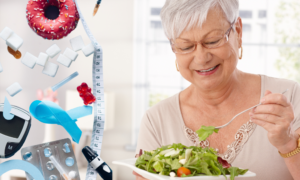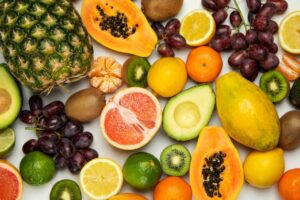Understanding food labels can be confusing and overwhelming, particularly when you are in a busy supermarket shopping for your family’s dinner with kids that are demanding their favourite foods.
The fact is that interpreting labels is a very important part of healthy eating for disease prevention. When we read labels correctly, we are able to recognise the natural foods rich in nutrients that help us fight disease and avoid highly processed foods with additives and low nutritional value.
In this article, we will focus on reading the Ingredients List and the Nutrition Information Panel which are the key sections on the label.
Follow these eight simple steps below to master your label reading skills and reduce your risk of developing chronic disease such as heart disease, cancer, obesity, diabetes and cognitive decline!
Why read labels?
You can’t go wrong with buying unpackaged foods like fruit, vegetables, nuts, whole grains and legumes. These wholefoods are the good stuff containing 100% real food with no additives.
When it comes to packaged food, we need to stay vigilant! Many products contain artificial additives, that are added to the food to improve their taste, look, feel, to prolong their shelf life and to save production costs.
Although artificial additives may not directly harm you when consuming them, it’s been proven that they accumulate in the body in the form of toxins and as result they weaken the immune system and further promote inflammation and disease (3,5,6).
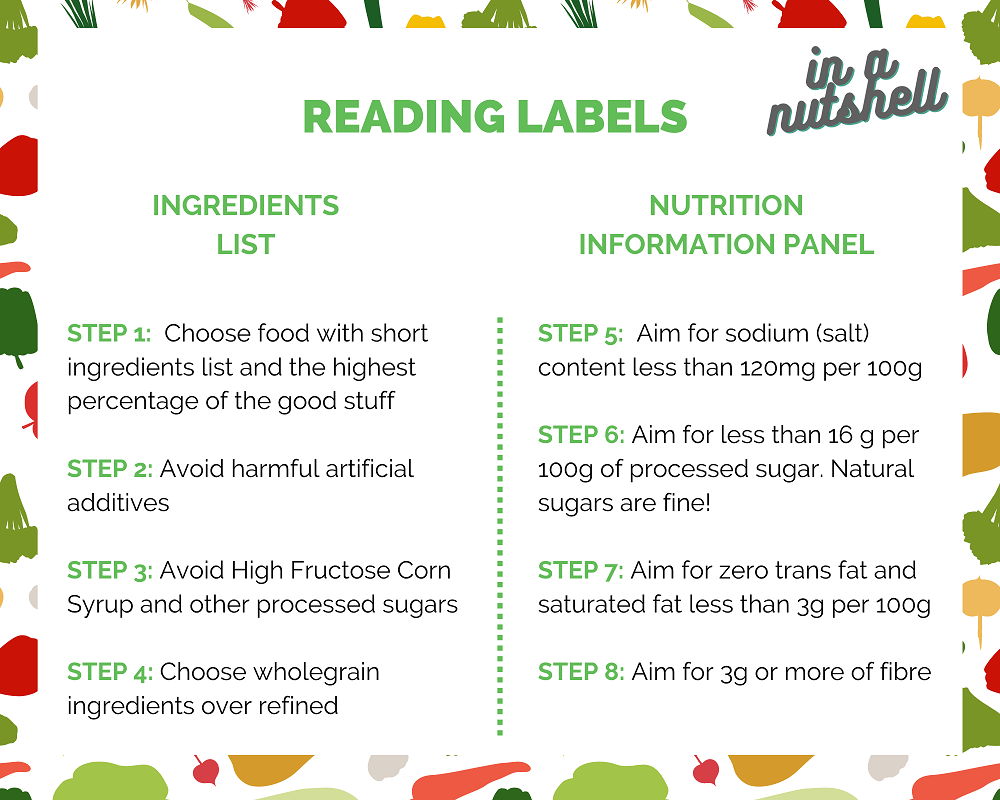
Ingredients List
The ingredients list on the packaging can be easily missed. It’s typically located at the back or side of the packaging in very small print. In Australia, all compound ingredients and allergens must be listed on the product labels. This means the ingredients list should give you the complete picture of what additives are present in the product.
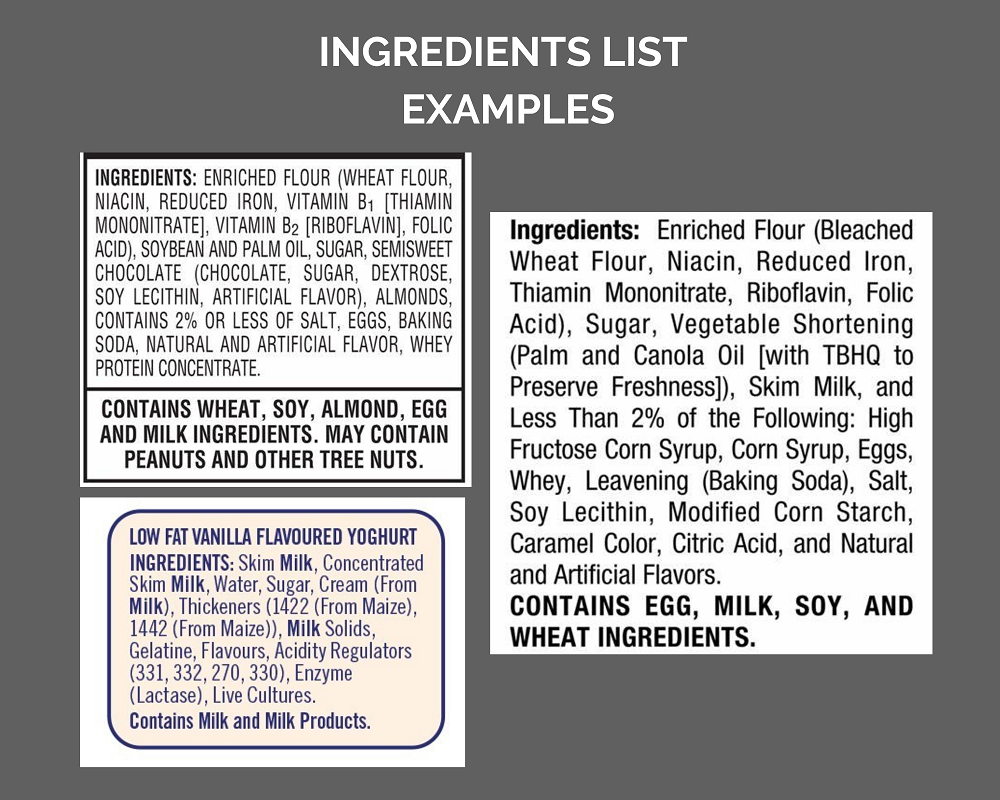
Step 1 - Check the ingredients list
When reading the ingredients list, notice the order and percentage of the ingredients. Each ingredient is listed in order of contribution from largest to smallest and is sometimes represented as a percentage of the total ingredients. Always aim to buy products with the highest percentage of the good stuff with minimal amounts of the bad stuff.
ACTIVITY 1: Compare the chickpea pasta and crackers below. The San Remo’s Pulse Pasta contains 75% of chickpea flour mixed with potato starch. The Table of Plenty’s Mini Rice Crackers contain a good percentage of organic brown rice as 71% combined with a good quality organic red rice (9%) and black rice (9%). Both products contain good amounts of nutritious ingredients (the good stuff).
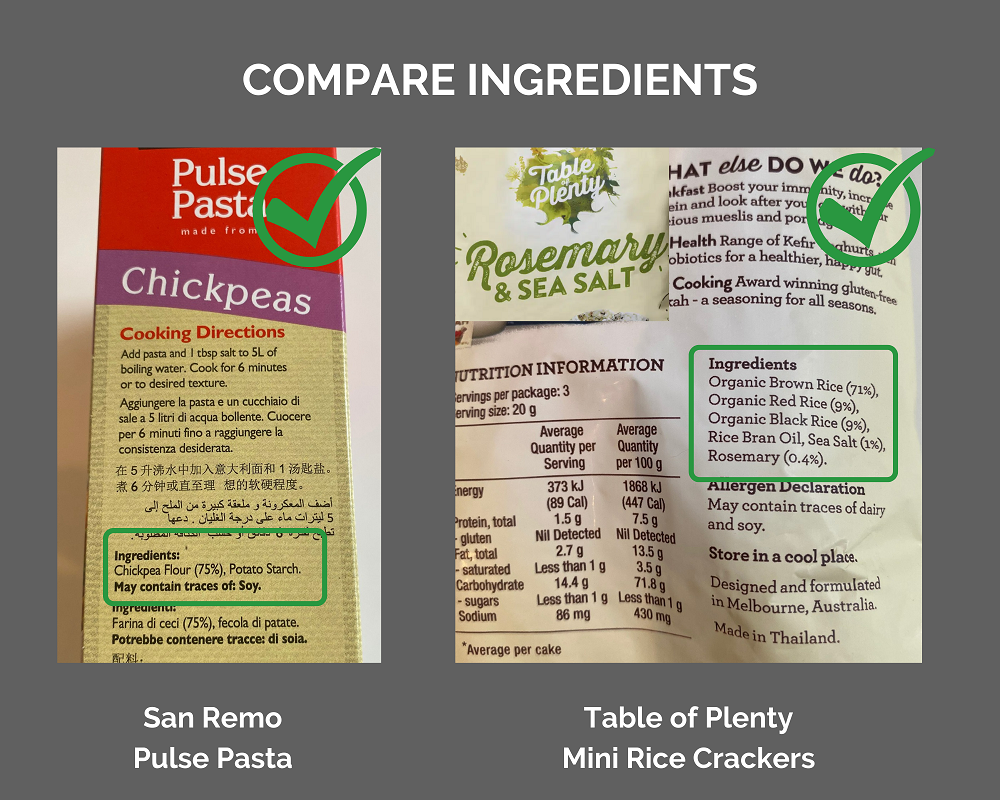
Processed foods have typically long and complex ingredients lists with many artificial additives so choosing products with less ingredients can be another helpful tool to avoid the bad stuff.
If the ingredients list is only one item (like in the picture below), then you are likely to be on to the good stuff – wholefood!
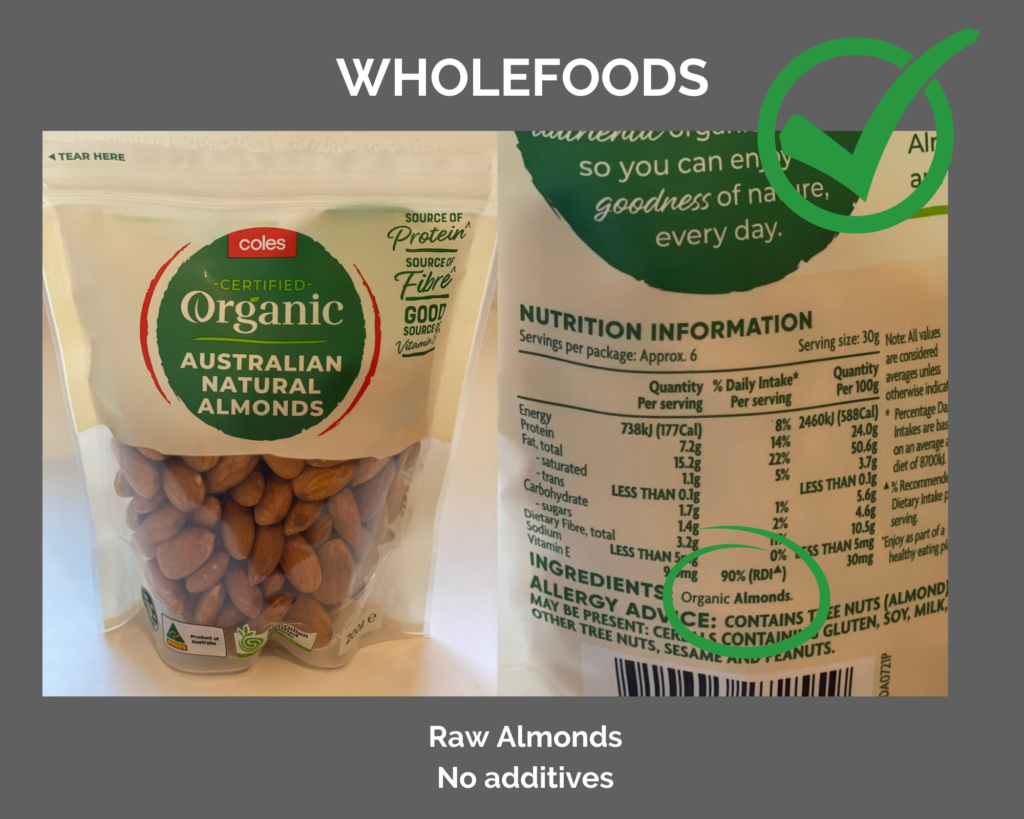
ACTIVITY 2: Compare the canned beans below. The Global Organics Red Kidney Beans on the left is a clear winner as they only include two ingredients: red kidney beans and water. The example on the right has some of the bad stuff because it includes added sugar, salt, firming agent and food acid to prolong the shelf life and improve the taste.
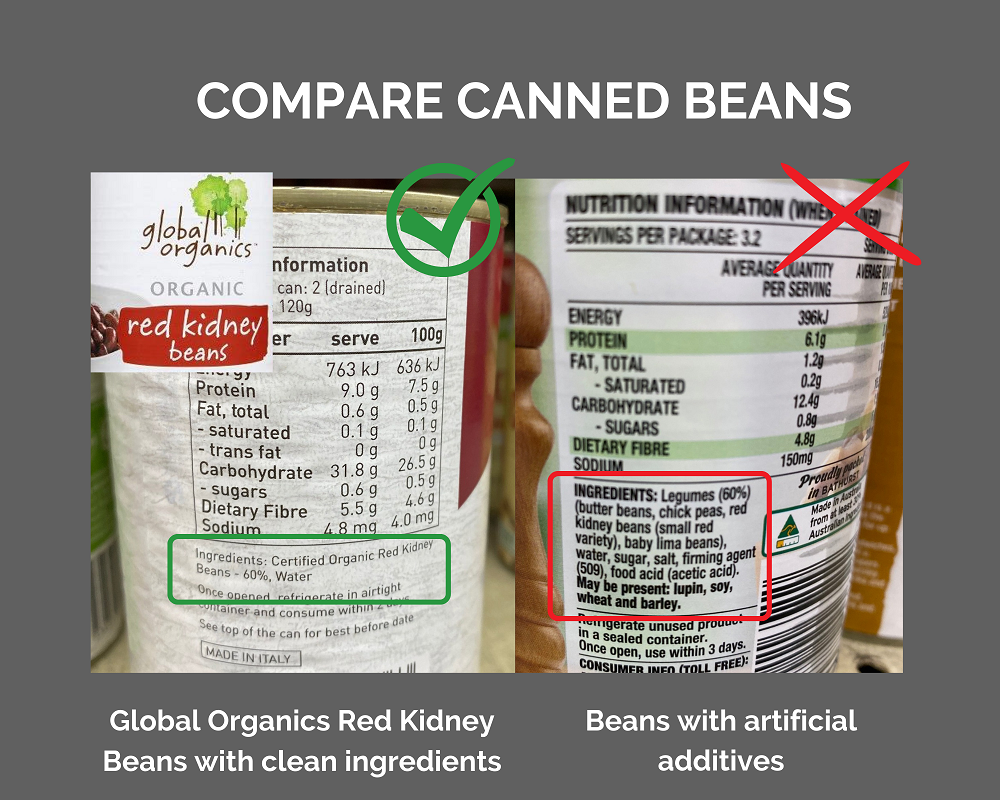
Step 2 - Avoid harmful additives
Avoid buying products with additives such as artificial colours, artificial and natural flavours, food dyes, preservatives, pesticides, antifoaming agents, firming agents, emulsifiers, stabiliziers, thickeners and flavour enhancers (MSG).
They are often listed under various names and numbers. You can check the full list of additives here.
The most harmful additives (the really bad stuff) that are linked to many health problems are listed below – avoid them at all cost!
The Bad Stuff
- Mono-Sodium Glutamate (MSG) (E620-625)
- Acesulfame-K (E950)
- BHT (Butylated Hydroxytoluene) and BHA (Butylated Hydroxyanisole) (E30)
- Aspartame (E951)
- Cyclamate (E952)
- Lestra
- Trans Fat
- Propyl Gallate (E310)
- Propylene Glycol Alginate (E405)
- Potassium Bromate (E924)
- Salt nitrite and nitrate (E249, E250, E251, E252)
- Food colouring (E101 – E111, E120 – E129, E130-E182)
- High Fructose Corn Syrup (HFCS)
- Sodium Sulfite (E221)
- Sulfur Dioxide (E220)
ACTIVITY 3: Compare the two products below. The Table of Plenty’s Mini Rice Crackers on the left include all clean ingredients while the potato chips on the right include a number of flavour and texture enhancers, sugars and preservatives including MSG (621, 631, 627).
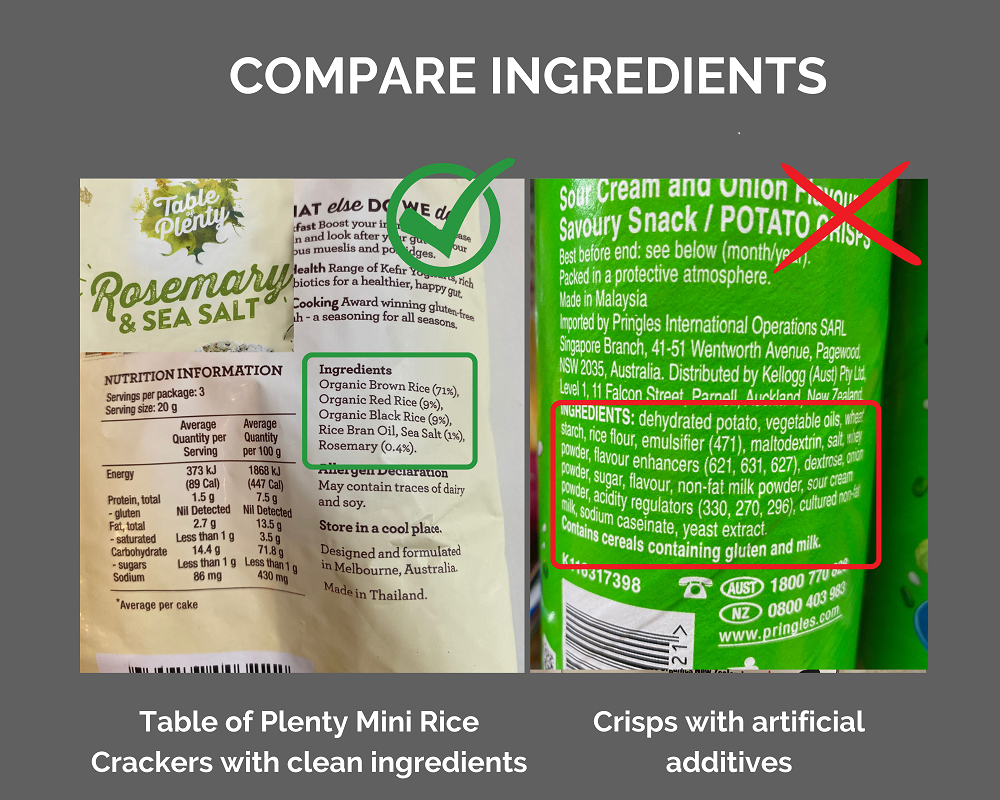
Step 3 - Limit processed sugar
Check the ingredients list to avoid products that include processed (refined) sugars. Processed sugars are linked with increased risk of diabetes, heart disease and other chronic diseases (3,4,5,6).
The Bad Stuff
Processed sugars are often hidden under a heap of different names such as… white, castor, icing, brown, raw, cane, fruit, date, grape, demerara, invert, muscovado, beet, glucose, dextrose, fructose, galactose, mannose, lactose, maltose, polydextrose, maltodextrose, sucrose, malt, rice malt, barley malt, malt extract, corn syrup, golden syrup or rice syrup…
The most harmful processed sugar is High Fructose Corn Syrup which is manufactured using chemicals and often contaminated with mercury (6).
The Good Stuff
Look for products with healthier (natural) sugar alternatives which are dates, date syrup, fruit purees, honey, agave syrup, maple syrup and coconut sugar.
Step 4 - Choose whole grains
Choose wholegrains like whole-wheat, whole-grain products instead of refined grains. Refined wheat flour can have less than one quarter of the fibre you would find in whole wheat flour. This is really important to note, as a lower fibre content causes rapid sugar absorption in the body and dangerous swings in glucose levels (4).
The Bad Stuff
Ingredients that contain words such as white, enriched, fortified, bleached are refined grains that should be avoided.
The Good Stuff
Words like whole, cracked, sprouted, stone ground and sprouted are accepted terms that can be used to describe whole grains on the ingredients list.
ACTIVITY 4: Refer to the below table for examples on whole and refined carbohydrates.

The Nutrition Information Panel
The Nutrition Information Panel located above the Ingredients List gives us additional insight on the amount of nutrients included in the food. The following nine ingredients are typically listed in the Nutrition Panel:
- Energy (kilojoules or calories)
- Protein (g)
- Total fat (g)
- Saturated fat (g)
- Trans fat (g)
- Total carbohydrates (g)
- Sugars (g)
- Fibre (g)
- Sodium (mg)
Some Nutrition Panels also show additional nutrients like calcium, iron or other micronutrients.

The “per 100g column” is useful if you want to compare nutrients in similar food products such as sodium amount used. The “per serving column” is useful if you want to know how much of a nutrient you will eat. (1)
Follow these additional steps to make sure the product doesn’t exceed the recommended amount of added salt, sugar and fat.
Step 5 - Check added salt
For disease prevention, it’s important to check the amount of added sodium (salt). Our body only needs small amount of salt around 1-2 grams per day and high consumption of salt leads to high blood pressure which is a major risk factor for heart disease.
The Heart Foundation recommends a daily maximum amount 5g of salt which translates to 2000 mg salt. This is about a teaspoon of salt. However, the most Australians are eating a double the amount (9g of salt a day) according to studies. (2)
To meet the recommended daily intake, food with less than 400mg per 100g are acceptable, and less than 120mg per 100g are the best (1).
Be aware that all the following ingredients contribute to salt content: baking powder, booster, celery salt, garlic salt, sodium, meat or yeast extract, onion salt, MSG, rock salt, sea salt, sodium bicarbonate, sodium metabisulphite, sodium nitrate, nitrate or stock cubes.
ACTIVITY 5: Compare two sauces with varying amount of salt. The Coles Organic Passata Sauce contains 8mg of sodium per 100g which meets the ideal recommended sodium content while the other pasta sauce exceeds the ideal range with 377mg of sodium per 100g.
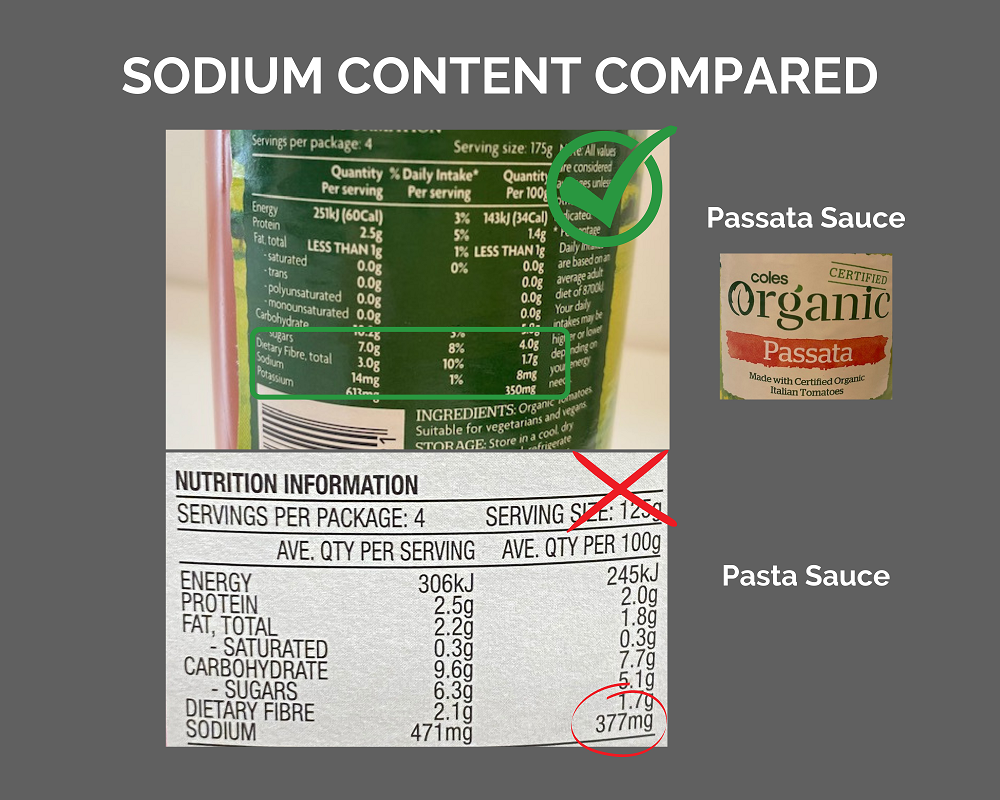
Step 6 - Understand sugar content
The sugar content listed in the Nutritional Information Panel is not indicative of the type of sugar in the product. Always check first what type of sugar is listed in the ingredients list (step 4) before looking at the sugar content in the nutrition information table.
Natural sugars present in whole foods are good for disease disease prevention and can actually help with blood sugar control (3,5). Remember, we are always aiming to avoid refined sugars that is linked with increased risk of developing chronic disease (3,4,5,6).
For processed sugar, aim for sugar content less than 16g per 100g (approx. 4 teaspoon of sugar).
ACTIVITY 6: Compare these two muesli products from the Margaret River Muesli Company. Both products contain more than 16g sugar per 100g. However, the first product has no added sugars (inferring it contains only natural sugar) while Muesli 2 contains added (processed) sugar.
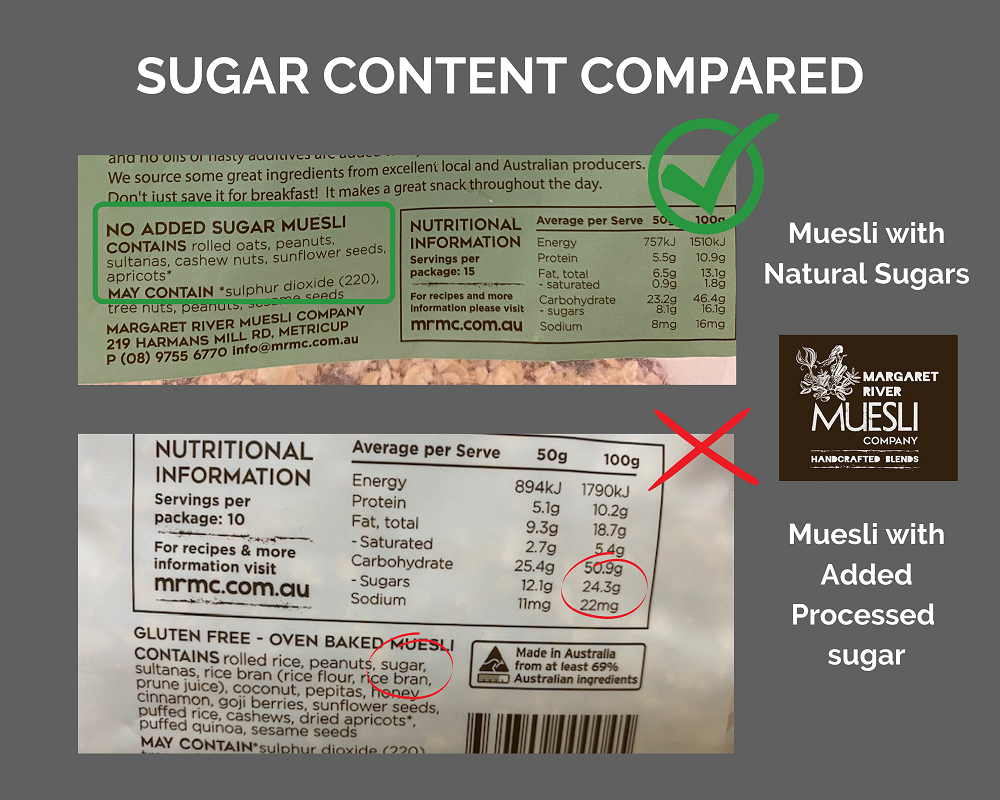
Step 7 - Avoid unhealthy fats
Trans and saturated fats are both linked to cancer and heart disease. Trans fats and saturated fats raise the bad cholesterol (LDL), leading to many problems such as narrowing and hardening of the arteries, heart attack and stroke (3). Trans fats are especially dangerous to your health as they decrease good cholesterol (HDL) and omega-3 acids in your body (3,5).
Trans fats are produced in the process called hydrogenation which makes them more stable for the use in the industrial food processing. Trans fat are also created when a vegetable oil is heated, cooled and reheated again (partly-hydrogenated oils).
Only choose products with zero trans fat listed on the nutrition information. Keep in mind though, that a product claiming to have zero trans fat can actually contain up to a half gram. This is why you also want to scan the ingredient list for words like hydrogenated vegetable oil, margarine, vegetable shortening or hydrogenated.
For saturated fat, aim for the lowest amount! Less than 3g per 100g is the best (1).
The following ingredients contain saturated fat: butter, milk, lard, cream, cheese, oils (coconut, palm, kernel, olive oil), meat.
Nuts, seeds and avocadoes are examples of healthy fats that you can eat as much as you want. They contain polyunsaturated fatty acids like Omega 3 and Omega 6 that are essential for good health.
Step 8 - Check Fibre Content
Fibre is not always listed in the nutrition information panels. Fibre is only found in plant products.
Remember, fiber is an important part of healthy eating for disease prevention, helping to reduce the risk of stroke, heart disease, type 2 diabetes.
Aim for foods that contain 3g or more fibre per serve (1).
Remember
Thank you for reading this article. We hope you got some benefits for you and your family.
Following these simple steps will give you the confidence you need to choose high quality food with minimal additives. Remember that whole natural foods (not packaged) like fruit, vegetables, wholegrains, legumes, nuts and seeds are those foods that are the foundation of healthy eating for disease prevention. They contain the disease-fighting nutrient that your body needs to thrive.
References
- Eatforhealth.gov.au , How to understand food labels, 2015
- The Heart Foundation, Salt and hear health, 2021,
- Michael Greger, MD, How not to die, 2015, London UK
- Colin Campbell, Thomas M. Campbell, The China Study, 2016, USA
- Joel Fuhrman, M.D., Eat to live, New York, 2011, USA
- Joel Fuhrman, M.D., Fast Food Genocide, 2017, New York, USA



